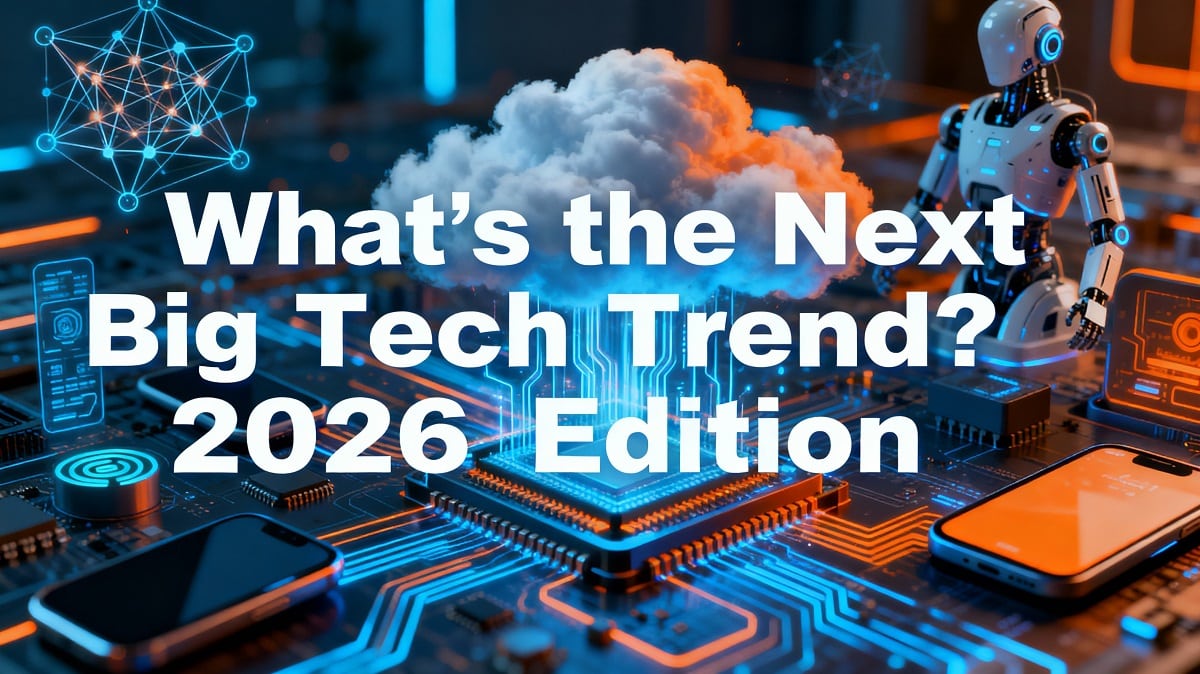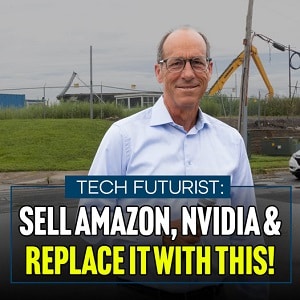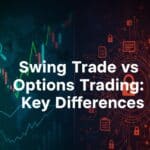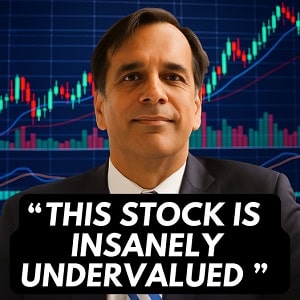Every decade has its defining “aha” moment for investors.
- In 2010, it was realizing the cloud wasn’t just an IT buzzword but a trillion-dollar backbone for business.
- In 2015, it was mobile—when every company scrambled to fit in your pocket.
- In 2020, artificial intelligence escaped the lab and landed in everyone’s daily life.
Now, standing on the edge of 2026, every serious investor I know is asking the same question:
What’s next?
And that’s not a casual curiosity. It’s the question that separates the investors who catch a new wave of wealth from those who spend the next five years wishing they had seen it coming.
We can all feel the tectonic plates of technology shifting again. The headlines scream AI this, AI that, but the real story is already evolving underneath.
When I talk to private equity friends, they’re quietly reallocating billions. Venture funds are loading up on a very specific class of companies—ones that don’t just use AI, but build the infrastructure that makes tomorrow’s AI-powered world possible.
That’s where the next big trend lives. And it’s happening faster than the public realizes.
The Investor’s Dilemma: Seeing It Before It’s Obvious
If you’re like me, you’ve probably felt the sting of being almost early. Maybe you spotted electric vehicles before Tesla took off… but didn’t act. Maybe you saw streaming before Netflix ruled… but thought it was too crowded.
We’ve all been there. Timing isn’t about luck—it’s about understanding where technology is in its adoption curve and when Wall Street finally wakes up to it.
That’s why I spend my evenings digging through SEC filings, investor transcripts, and small-cap charts. Because patterns repeat. And right now, the pattern I’m seeing reminds me eerily of 2016, just before the AI and cloud run-up began.
Why I’m Paying Attention to 2026 Now
Here’s what the data says:
-
Global spending on emerging tech infrastructure—from edge computing to next-gen semiconductors—is projected to grow at more than 25% annually through 2028.
-
Private capital is quietly rotating from consumer apps to enabling technologies: energy efficiency, quantum-safe encryption, synthetic data, and real-time computing.
-
Governments are passing incentives for digital-energy convergence—think smart grids, autonomous logistics, AI-optimized manufacturing.
In other words, 2026 won’t be “the year of another app.” It’ll be the year that the physical world becomes programmable.
That’s the investable story—one that only a handful of researchers, including Jeff Brown of The Near Future Report, are mapping with any precision. Jeff’s team has been flagging this shift for over a year, identifying the companies that provide the “picks and shovels” of this next era.
I’m not a journalist chasing headlines; I’m an investor who learned the hard way to respect cycles. Back in 2008, I bought into solar energy too early and watched a promising position bleed 70%. Painful—but instructive. By 2013, I recognized the same setup in cloud computing, acted decisively, and that single move multiplied my portfolio.
That pattern—understanding where a technology is on the curve and who is about to scale it—is exactly what keeps me profitable today.
When I read Jeff Brown’s research, I don’t see hype; I see someone who uses the same discipline—grounded, data-driven, and focused on where institutional capital is going next.
That’s why I pay attention when his Near Future Report singles out an emerging tech infrastructure play. He’s not guessing trends; he’s following the money before the headlines catch up.
A Hint at What’s Coming
So, what’s the next big tech trend for 2026?
Here’s my thesis in one sentence:
We’re entering the age of Intelligent Infrastructure — where AI, energy, and hardware converge to rebuild the physical backbone of the economy.
- Think autonomous logistics networks.
- Think AI-optimized energy grids.
- Think chips that don’t just compute, but learn in real time at the edge.
This is bigger than any single innovation because it touches everything—industry, transportation, energy, defense, healthcare.
And investors who recognize that convergence early stand to capture the same kind of asymmetric returns we saw with cloud adoption in 2010 and mobile platforms in 2015.
In the next section, I’ll break down the first key insight driving this transformation—the technology enabler that’s quietly positioning itself to be the backbone of 2026’s trillion-dollar trend.
👉 If you want to get ahead of that curve instead of chasing it, it’s worth exploring Jeff Brown’s latest analysis inside The Near Future Report.
The Infrastructure Behind the AI Era
If you want to understand where the next wealth wave begins, forget the headlines about chatbots or celebrity AI tools. Those are the applications — the shiny layer investors see when it’s already too late.
The smart money always moves one layer deeper: infrastructure.
The Real Gold Rush Isn’t in the Apps
Think back to the California gold rush. The people who struck it rich weren’t the miners; they were the merchants selling picks, shovels, and denim.
In 2026, that’s exactly what’s happening in tech. The gold is artificial intelligence, automation, and data-driven everything. The picks and shovels are the specialized chips, edge-network systems, and energy platforms that make AI possible at scale.
Every investor I know is watching the same macro chart:
AI workloads are doubling roughly every six months, but traditional compute capacity can’t keep pace.
That gap — between the demand for intelligence and the ability to supply it — is the opening where trillion-dollar companies are born.
Compute Is the New Oil
In 2026, compute power has become the new oil. Whoever controls the energy-efficient processing units, data pipelines, and localized AI compute nodes controls the new economy.
We used to think of chips as “semiconductors.”
Now they’re intelligence engines — purpose-built for neural networks, natural-language modeling, and real-time decision-making at the edge.
-
Edge AI chips: Built to process data near the source — in factories, drones, vehicles, and medical devices — rather than in distant cloud servers.
-
Neuromorphic processors: Designed to mimic how the human brain learns and adapts; these will redefine speed-per-watt efficiency.
-
Quantum-resistant architectures: As quantum computing emerges, chipmakers are racing to design secure, future-proof hardware.
This quiet arms race is why semiconductor R&D spending has surged more than 40% since 2021, even as consumer electronics cooled.
Jeff Brown’s Near Future Report has been calling this the “Intelligence Infrastructure Era” — the phase where the biggest returns come not from the companies using AI, but from those enabling it.
The Data Deluge Problem
Every new device, car, factory robot, or drone now generates oceans of data. By 2026, global data creation will top 180 zettabytes — almost double the total from 2023.
That’s like every person on earth producing 23 terabytes of information a year.
Where does all that go? Where is it processed, filtered, and transformed into usable intelligence?
Not in traditional cloud centers alone. They’re too slow, too energy-hungry, and too far from the action.
The new battleground is edge compute infrastructure — miniaturized, distributed, AI-capable processing centers located inside everything from autonomous delivery trucks to factory floors.
Investors who understand this shift can identify the next “Nvidia-before-Nvidia.”
The Hidden Supply Chain Play
Everyone knows Nvidia. That ship has largely sailed. The next wave of returns lies deeper in the supply chain — among the companies producing the materials, components, and power systems that feed this compute explosion.
A few examples to illustrate how this plays out (not recommendations, just context):
-
Advanced substrate manufacturers that supply the multilayer materials connecting chiplets.
-
Precision tool makers building the lithography and deposition systems required for 2-nanometer manufacturing.
-
AI-specific cooling solutions companies creating liquid-based thermal systems to handle the heat of data-dense processing.
-
Power-management semiconductor firms optimizing voltage and current for AI inference chips.
These aren’t household names — yet.
But they’re the infrastructure glue that allows AI, robotics, and automation to function.
When Jeff Brown identifies these companies in The Near Future Report, he isn’t speculating on fads; he’s spotlighting the foundations of the next industrial age.
The Energy Angle — When Silicon Meets Kilowatts
Here’s a truth Wall Street is just waking up to: AI doesn’t just consume data; it devours energy.
A single large-language-model training run can use as much power as 100 U.S. households burn in a year.
That means the most valuable emerging tech investments over the next five years won’t just be in chips — they’ll be in energy efficiency and intelligent power distribution.
Watch for three categories accelerating into 2026:
-
Smart Grids: AI-driven grids that dynamically route electricity to data centers and industrial loads in real time.
-
On-site Micro-generation: Small, modular power sources co-located with compute hubs, reducing transmission loss.
-
Solid-state batteries: High-density storage enabling stable power for edge networks.
These are the unglamorous but essential enablers of the next tech expansion.
Why the Market Still Misprices It
Most investors still think “AI = software.” That’s why infrastructure stocks often trade at low multiples despite explosive growth potential.
But by 2026, as cloud bills climb and data traffic explodes, the market will realize: without intelligent infrastructure, AI collapses under its own weight.
That’s the window we’re in right now — the quiet accumulation phase when institutional capital starts to build positions before retail attention floods in.
I’ve watched this movie before:
-
2008–2010, when cloud-data providers looked like boring utilities until they didn’t.
-
2013–2015, when mobile chip suppliers tripled before the app economy even peaked.
History doesn’t repeat perfectly, but it rhymes. And right now, the rhythm sounds familiar.
Why Jeff Brown’s Lens Matters
You don’t need to spend nights parsing semiconductor white papers. That’s Jeff Brown’s full-time obsession.
His Near Future Report approach triangulates early-stage patent filings, supplier-order data, and government R&D allocations — the same breadcrumbs that tipped him off to 5G infrastructure plays years before the mainstream caught on.
He’s now tracking what he calls “Intelligent Infrastructure Accelerators.”
These are small-to-mid-cap firms at the intersection of compute, power, and AI-driven automation — exactly where institutional capital is rotating.
For independent investors, that kind of research can be the difference between watching the next tech revolution on CNBC and owning a slice of it.
The 2026 Takeaway
When people ask, “What’s the next big tech trend?” the instinct is to name a product — robotics, biotech, quantum. But the real answer is simpler and more powerful:
The next big tech trend of 2026 is the infrastructure that makes all those revolutions possible.
Compute is the new oil. Energy is the new bandwidth. And the companies that solve those two bottlenecks will define the market’s next decade.
If you want to go deeper into which firms fit that profile — the ones Jeff Brown’s team believes could be the “Nvidia-style” leaders of the 2026 cycle — his latest Near Future Report lays out the data.
Because by the time the mainstream calls it “the next big tech trend,” the early stage will already be over.
The Data Economy & The Biotech Convergence
If computing power is the engine of the next big tech trend, data is the fuel — and biology is fast becoming its newest frontier.
Investors who understand how those two worlds are colliding—digital and biological—will have a front-row seat to the biggest wealth transfer since the birth of the internet.
The Rise of the Data Economy
A decade ago, data was treated like exhaust—something companies collected and mostly ignored. Now it’s the world’s most valuable commodity, and 2026 will mark the point where the data economy becomes self-aware.
I don’t mean that metaphorically.
AI models are learning not just from data, but from data about data: where it comes from, how accurate it is, how valuable it might be in a specific context.
And that meta-awareness is spawning an entirely new category of opportunity — what Jeff Brown calls “data monetization infrastructure.”
The New Data Pipeline
We’re moving from data storage to data liquidity.
Think of it as Wall Street for information — where data flows through verified, tokenized channels and earns yield based on utility.
Three technologies are converging to make that possible:
-
Decentralized storage and compute networks – systems that let enterprises rent unused compute and storage globally, like Airbnb for servers.
-
Synthetic data generation – AI-created training data that’s statistically accurate, removing privacy and bias issues.
-
Data provenance tracking – using blockchain-like ledgers to verify where data came from and whether it’s trustworthy.
This is the invisible plumbing of the next internet—the intelligent data layer.
Why This Matters to Investors
As AI becomes ubiquitous, the bottleneck isn’t creativity; it’s quality data. You can have the smartest algorithm in the world, but if your training data is flawed, your results are garbage.
That’s why some of the best tech stocks of 2026 won’t be software brands—they’ll be data providers, aggregators, and validation-platform builders.
Here’s what to watch:
-
Companies creating secure synthetic data for regulated industries like healthcare and finance.
-
Platforms offering data exchange marketplaces, allowing corporations to buy and sell anonymized datasets.
-
Startups using AI agents to clean and label data for machine learning, a sector projected to exceed $10 billion by 2027.
These businesses operate behind the scenes, but they’ll quietly power every future AI product.
The “Picks and Shovels” of Data
Let me make this concrete.
When Google launched its first large-scale AI models, 80% of the cost wasn’t the software—it was data preparation. Cleaning, labeling, verifying, and augmenting datasets consumed massive resources.
Now imagine the companies that automate that process—who make AI development plug-and-play.
That’s why venture capital in “data enablement startups” has grown faster than in consumer AI apps since 2024. And according to IDC, corporate spending on data infrastructure software will hit $200 billion annually by 2026.
Jeff Brown’s Near Future Report has been all over this. He calls it “The Data Dividend” — the phase where investors can profit not just from data use, but from data ownership and movement.
This isn’t a Silicon Valley buzzword game. It’s the foundation of how business intelligence, automation, and personalization will function for the next decade.
The Data-Energy Symbiosis
One more piece that’s often overlooked: data is power-hungry.
As I covered in Section 2, the compute infrastructure powering AI is colliding head-on with energy constraints. That means data and energy are becoming interdependent.
We’re already seeing energy companies partnering with data centers to co-locate computing next to renewable power generation.
By 2026, it’ll be normal for utilities to have data monetization arms — treating information like electricity: produced, distributed, and priced dynamically.
That opens a completely new field of data-energy arbitrage investing — a phrase that barely exists today but will be mainstream by 2028.
The Biotech Convergence
Now, let’s pivot to the third and perhaps most explosive frontier — the collision between technology and biology.
For decades, biotech and tech investors lived in separate worlds. One group analyzed DNA and proteins. The other obsessed over semiconductors and code. In 2026, those two worlds fuse.
And that fusion—digital biology—is going to make previous tech revolutions look small.
Biology Is Becoming Programmable
The same machine-learning algorithms that predict what you’ll buy next are now designing new proteins, therapies, and materials.
We’re witnessing the digitization of life itself.
In labs across the world, AI-driven platforms are decoding and simulating biology faster than any human researcher ever could:
-
Generative biology models can design therapeutic molecules in hours instead of months.
-
Lab automation robots conduct experiments 24/7, collecting millions of data points for AI to learn from.
-
Digital twins of cells and organs allow scientists to test treatments virtually before running real trials.
This convergence of biotech and AI is projected to unlock $4 trillion in new market value over the next decade.
The Investment Implication: From Pipelines to Platforms
Traditional biotech investors think in terms of drug pipelines — one therapy at a time. But the new model is platforms: algorithmic systems that can generate hundreds of potential candidates simultaneously.
This is where investors will see asymmetric upside.
Because instead of betting on one molecule succeeding, you’re betting on the system that invents them.
Jeff Brown’s research team at The Near Future Report calls these AI Bio-Platforms — a new asset class of companies at the intersection of computational biology, robotics, and cloud infrastructure.
They don’t just accelerate discovery; they completely rewrite the economics of R&D.
Real-World Example: The AI-Lab Revolution
Take a moment to consider how this plays out.
In 2024, one mid-cap biotech used a generative AI model to identify a new antibiotic compound—after human researchers had failed for 20 years.
The process took less than two months and cost under $100,000.
Now imagine that multiplied across oncology, genetics, and synthetic materials.
That’s not science fiction. It’s where venture and institutional capital are quietly rotating right now.
The Hardware Connection
And here’s where this ties back to the earlier insight: compute infrastructure.
AI-driven biology requires massive, specialized processing. That means the same edge and data-infrastructure enablers we discussed in Section 2 are also fueling biotech’s rise.
Every new discovery adds terabytes of genomic data. Every simulation needs low-latency compute. So, the hardware arms race is directly linked to biotech’s breakthrough speed.
That’s why, in my opinion, investors who understand this overlap — tech and bio — are sitting at the most asymmetric opportunity of our lifetimes.
The Human Longevity Angle
Let’s be honest: nothing drives markets like the promise of longer, healthier life. And for the first time, that promise looks credible.
AI-enabled precision medicine, gene editing, and real-time diagnostics are converging into what some analysts call the longevity economy — a sector projected to hit $27 trillion by 2030.
In 2026, you’ll see the first wave of publicly traded companies offering AI-based personalized health platforms: analyzing your genetics, biomarkers, and lifestyle data to tailor real-time interventions.
That’s not speculative—it’s already happening in clinical pilots from Boston to Singapore.
The next generation of winners won’t be the Big Pharmas alone. They’ll be the software-defined biology firms creating the algorithms that guide every medical decision.
Why Wall Street Is Missing It
Wall Street still classifies biotech as “healthcare” and tech as “information technology.” But the next decade won’t respect those silos.
The companies that dominate 2026–2030 will be hybrids — part lab, part software shop, part data-infrastructure operator.
And because that doesn’t fit neatly into an index or ETF yet, they’re mispriced. That’s your edge as a forward-looking investor.
Connecting the Dots: From Data to DNA
Let’s zoom out for a second.
In Section 2, we talked about intelligent infrastructure — the hardware backbone of the AI era.
Now we’ve added two more layers:
-
The data economy, where information becomes liquid, tradable, and valuable.
-
The biotech convergence, where that intelligence turns inward — decoding life itself.
Together, these aren’t separate trends. They’re a stack.
And that’s the key to understanding the next big tech trend of 2026.
The stack looks like this:
-
Hardware — Edge compute, semiconductors, power systems.
-
Data Infrastructure — Storage, exchange, validation.
-
AI Layer — Algorithms that interpret and predict.
-
Biological Interface — Turning intelligence into human, medical, and environmental impact.
Every one of those layers has its own set of emerging tech investments. But the real power is in the convergence — the companies sitting at the intersection of two or more layers.
That’s where Jeff Brown’s research shines, because The Near Future Report doesn’t chase fads. It maps where multiple exponential curves collide — and where investors can position before the feedback loop goes vertical.
The 2026 Thesis So Far
Let’s summarize the three key insights we’ve covered so far:
-
Intelligent Infrastructure: Compute and energy are the new oil; hardware and power optimization drive the next decade.
-
Data Economy: Data becomes liquid, tradable, and self-monetizing — new wealth flows from its movement.
-
Biotech Convergence: AI turns inward, decoding biology and rewriting healthcare, materials, and life itself.
Those are the three pillars of the next big tech trend. Together, they define the coming transformation of how we build, think, and live.
But before we rush to chase every shiny ticker symbol, let’s deal with the biggest concern investors have about all this — the fear that it’s just hype.
Because it’s not the first time Wall Street has promised “the future.” And some of us have the scars to prove it.
Is This Just Another Hype Cycle?
If you’ve been around investing for more than a few years, you’ve seen this show before.
The media hypes a new technology. Everyone talks about it. Early investors make headlines. Then, inevitably… disappointment sets in.
Remember the dot-com bubble? Many investors jumped in because “the internet was the future.” But without solid infrastructure or revenue models, they lost fortunes.
Or consider 3D printing in 2014. Headlines promised it would revolutionize manufacturing overnight, yet most startups stumbled, and only a handful delivered real returns.
So it’s natural to ask:
“How do I know that the next big tech trend of 2026 isn’t just another overhyped story?”
That’s the exact question I ask myself every day before deploying capital. And the answer always comes back to one principle: track the people and research that get it right before the headlines arrive.
Why Most Investors Get Burned
Here’s the pattern I see repeatedly:
-
Everyone notices the hype too late.
By the time AI chatbots dominate the news, the early winners have already doubled or tripled. -
They chase applications instead of infrastructure.
Wall Street obsessively focuses on visible products—apps, tools, devices—while ignoring the hidden enablers of growth. -
They ignore the adoption curve.
Real tech adoption takes time. Investors who buy at the peak of hype pay a premium for the innovation, not the fundamentals.
That’s why most “hot tech stocks” fail to deliver meaningful gains. They are either overvalued or miss the structural growth underpinning the trend.
Enter Jeff Brown: Why Track a Proven Visionary
This is where Jeff Brown stands apart.
He doesn’t follow the headlines—he follows the data, the patents, and the capital flows. Over the past decade, he’s consistently flagged transformative technologies years before the mainstream caught on.
Let me give you a few concrete examples:
-
5G Technology:
In 2016, Jeff identified the companies set to profit from the 5G rollout—well before most retail investors even understood what 5G was. His subscribers saw triple-digit gains from hardware suppliers and chipmakers that eventually dominated the market. -
Artificial Intelligence Chips:
In 2019, Jeff highlighted a handful of semiconductor firms poised to benefit from AI adoption in enterprise and cloud infrastructure. Investors who acted early captured the growth long before the AI boom made headlines in 2021–2022. -
Gene Editing & Biotech:
In 2020, he recommended a select group of biotech innovators using CRISPR technology. While the broader market didn’t yet recognize the opportunity, early subscribers had exposure to some of the fastest-growing biotech plays of the decade.
These aren’t anecdotes—they’re verifiable, actionable predictions that preceded mass adoption. That track record separates true insight from hype.
How to Spot Real Tech Trends vs. Fads
Here’s the framework I use, and the same one Jeff Brown’s research team applies in The Near Future Report:
-
Structural Necessity:
Is this technology enabling other industries, or is it a flashy product with no backbone?
Example: AI infrastructure, edge computing, and data pipelines are necessary for multiple markets—not just trendy apps. -
Capital Commitment:
Are institutional investors, governments, and large corporations quietly funding it? Big money flows precede the headlines. -
Early but Measurable Adoption:
True trends show exponential growth in usage, patents, or infrastructure deployment before the general public notices. -
Sustainable Economics:
Look for companies with a scalable business model, repeatable revenue, or strategic market positioning.
Jeff Brown applies this exact methodology, which is why his readers consistently get early exposure to opportunities others overlook.
The 2026 Test Case
Let’s apply this to 2026:
-
Intelligent Infrastructure: Check. Needed for AI, robotics, and automation.
-
Data Economy: Check. Data is now a tradable, monetizable commodity.
-
Biotech Convergence: Check. Life sciences are being rewritten by AI and automation.
The difference between a fad and a trend is crystal clear here: these technologies are structurally embedded, capital-intensive, and adoption-driven.
That’s why I personally trust Jeff Brown’s lens. He doesn’t chase popularity; he tracks structural change.
Addressing the Skeptic: “What If I’m Too Late?”
It’s a fair question. Every investor fears catching the tail end of a boom. But the beauty of the 2026 tech stack we’ve outlined is this:
We’re still in the quiet accumulation phase, where institutional and smart-money moves precede retail frenzy.
History repeats: early investors in 5G hardware or AI chips didn’t wait for media coverage—they acted when signals were subtle.
By paying attention now — and following guidance from research like Jeff Brown’s Near Future Report — you position yourself before the wave goes vertical.
Jeff’s approach isn’t about guessing. It’s about evidence-based trend mapping:
-
Tracking patents and intellectual property filings.
-
Analyzing supplier order data and production ramp-ups.
-
Monitoring government incentives, R&D spending, and regulatory trends.
In short, he provides the roadmap from concept to market dominance, allowing investors to participate in real growth rather than speculative hype.
Subscribers gain access to:
-
Early-stage tech companies set to explode.
-
Practical advice on positioning capital for maximum leverage.
-
Actionable insights grounded in verifiable data — not headlines.
That’s why I consider The Near Future Report an indispensable resource for anyone serious about emerging tech investments in 2026.
Timing Is Everything
The window to act is never infinite. By the time a trend becomes obvious to the masses, valuations reflect hype, not fundamentals.
That’s why Jeff Brown emphasizes early but calculated exposure:
-
Identify structural enablers.
-
Invest in companies benefiting from adoption curves.
-
Avoid crowded trades that only reflect media attention.
It’s the difference between a 20% annual gain and a triple-digit windfall.
Bottom Line
Tech hype cycles will always exist. Headlines will always exaggerate. Fads will always lure the unprepared.
But real trends — the ones that reshape industries and create lasting wealth — are backed by infrastructure, adoption, and capital flows.
Jeff Brown’s track record proves that identifying these trends early is possible — and profitable.
For investors ready to move beyond hype, the path is clear: follow the research that uncovers structural change before the market catches up.
If you want to see which companies Jeff Brown believes are set to dominate 2026’s next big tech trend, his latest Near Future Report gives subscribers the exact insights and recommendations I rely on myself.
Position Yourself Before the 2026 Tech Wave
We’ve walked through the pillars of the next big tech trend for 2026:
-
Intelligent Infrastructure — the hardware and energy systems powering AI, robotics, and automation.
-
The Data Economy — where data becomes liquid, monetized, and self-reinforcing.
-
Biotech Convergence — AI rewriting biology, medicine, and life sciences at a breathtaking pace.
Now, here’s the reality every serious investor faces: seeing these trends isn’t enough. You need to position your capital strategically before the masses catch on.
Why Timing Matters in 2026
History repeats in cycles, particularly in technology investing:
-
Early investors in cloud computing reaped outsized gains long before the general public understood the opportunity.
-
Early 5G chip adopters captured triple-digit returns while headline investors were still reading about network rollouts.
-
AI chip investments in 2019-2021 quietly multiplied wealth for those ahead of the curve.
2026 is no different. The trends we’ve outlined are still in the quiet accumulation phase.
Institutional and insider capital is moving now. By the time media coverage spikes and retail FOMO kicks in, valuations will reflect hype, not fundamentals.
Acting now — before the trend is obvious — is how you create asymmetric upside.
How Jeff Brown’s Near Future Report Can Help
Here’s where having a guide like Jeff Brown makes a measurable difference:
-
Track Record You Can Trust: Jeff has repeatedly identified transformative tech trends years before they hit the mainstream. 5G, AI infrastructure, biotech breakthroughs — he has a documented history of actionable calls.
-
Research-Based Recommendations: Subscribers don’t get opinions; they get evidence-driven analysis, including data on patents, R&D, and capital flows.
-
Early Access to Emerging Opportunities: Jeff identifies companies before the public notices — the same way early investors captured massive gains in past tech waves.
I’ve personally relied on his research to structure positions in emerging tech investments. Every time a trend became mainstream, the companies highlighted in his reports had already moved, providing substantial advantage over those waiting for headlines.
Why You Can’t Wait
The longer you delay, the more you risk:
-
Paying inflated prices when the trend hits public attention
-
Missing early-stage winners that multiply before the media notices
-
Losing the strategic edge that informed investors hold today
By 2026, the next wave isn’t just another app or a buzzy gadget. It’s the infrastructure, data systems, and biotech convergence that will power the economy for decades.
That’s why acting now isn’t just smart — it’s essential.
Your Next Step
Here’s what to do:
-
Click through to Jeff Brown’s Near Future Report:
Access The Near Future Report -
Review his latest analysis on emerging tech investments, infrastructure plays, and biotech platforms poised for growth in 2026.
-
Position your portfolio early, taking advantage of the quiet accumulation phase before the trend goes vertical.
Jeff’s research shows you exactly which companies are most likely to dominate, how early to invest, and the reasoning behind each recommendation — saving you years of independent research and trial-and-error investing.
Why Now Matters
We are at a pivotal moment: the technologies, infrastructure, and data-driven platforms that will define the next decade are aligning.
Those who act now, with guidance from credible, proven insight, will capture wealth before the mainstream notices.
Waiting for headlines or retail hype is a recipe for mediocre returns. In 2026, the early movers will reap the rewards, and Jeff Brown’s Near Future Report gives you the roadmap.
Closing Thoughts
I’ve invested in multiple tech waves over the past decade, and the pattern is clear: early, informed exposure beats hype-chasing every time.
The next big tech trend is not coming tomorrow — it’s already unfolding today.
The companies, the data systems, and the biotech platforms that will define 2026 are already quietly positioning themselves.
If you want to see which companies Jeff Brown believes will lead this transformation, and get research-backed recommendations before the masses react, here’s your opportunity:
Subscribe to Jeff Brown’s Near Future Report Today
This is your chance to move ahead of the curve, align with structural tech trends, and participate in the wealth being created before it’s headline news.
Remember: the market rewards those who act with knowledge, discipline, and foresight.
2026 is shaping up to be the most exciting year for investors in decades — the question is, will you be watching from the sidelines, or will you be positioned to profit?
FAQ: The Next Big Tech Trend 2026
What is the next big tech trend in 2026?
The next big tech trend in 2026 focuses on intelligent infrastructure, the data economy, and biotech convergence. This includes AI-powered edge computing, data monetization platforms, and AI-driven biotech research. These areas create opportunities for investors seeking early exposure to transformative technologies. Jeff Brown’s Near Future Report highlights the companies best positioned to benefit from these trends.
How can I invest in emerging tech in 2026?
Investing in emerging tech requires identifying companies that provide the infrastructure, data systems, and biotech platforms supporting tomorrow’s breakthroughs. Rather than chasing popular apps or trends, early-stage exposure to companies flagged by research experts like Jeff Brown ensures you’re investing in the foundations of long-term growth. Near Future Report subscribers gain detailed insights into these actionable investment opportunities.
Is this just another tech hype cycle?
Not according to historical patterns and research-backed analysis. While hype exists, the next big tech trend of 2026 is driven by structural, multi-layer growth in hardware, data infrastructure, and biotech. Jeff Brown’s track record — spotting 5G, AI infrastructure, and biotech winners years before mainstream adoption — shows that early identification of these trends is possible and profitable.
Which sectors will benefit most from the 2026 tech wave?
Key sectors include:
- AI and edge computing hardware (chips, processors, intelligent infrastructure)
- Data economy platforms (storage, validation, marketplaces, synthetic data)
- Biotech convergence (gene editing, digital biology, AI-driven therapeutics)
- Energy efficiency and smart grids supporting AI and industrial automation
Investing in companies across these sectors is best guided by expert research like Jeff Brown’s Near Future Report, which identifies winners before they hit mainstream attention.
Are there tech stocks to buy now for 2026?
Yes — but timing and selection are crucial. The best opportunities are often not headline-grabbing companies, but those quietly building the infrastructure and platforms that enable future growth. Jeff Brown’s Near Future Report identifies these early-stage investment opportunities and provides subscribers with actionable recommendations before the broader market catches on.
Why follow Jeff Brown’s Near Future Report for investing?
Jeff Brown has a documented history of identifying transformative technology trends years before mainstream recognition. From 5G to AI and biotech breakthroughs, his research focuses on emerging tech investments with structural growth. The Near Future Report delivers subscribers:
- Verified early-stage opportunities
- Insights into adoption curves and market timing
- Recommendations grounded in data, patents, and capital flow analysis
For investors who want to position themselves ahead of 2026’s next big tech trend, following Jeff Brown’s analysis provides both credibility and actionable insight.
How soon should I act on these trends?
The earlier you act, the more potential upside you capture. Most trends experience a quiet accumulation phase before media attention and retail hype spike. Acting now — guided by research like Jeff Brown’s Near Future Report — allows investors to position themselves before valuations reflect mainstream awareness, maximizing potential returns.




































